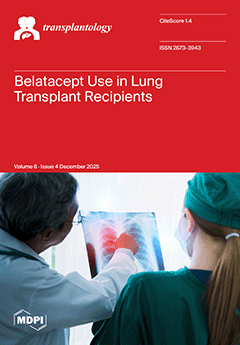Background/Objectives: Calcineurin inhibitors (CNI) contribute to renal dysfunction post-transplant. Belatacept is a renal sparing immunosuppressive agent. We sought to determine if the use of belatacept, as an alternative to a CNI-based maintenance immunosuppressive regimen ameliorates the effects of CNI-related nephrotoxicity in lung
[...] Read more.
Background/Objectives: Calcineurin inhibitors (CNI) contribute to renal dysfunction post-transplant. Belatacept is a renal sparing immunosuppressive agent. We sought to determine if the use of belatacept, as an alternative to a CNI-based maintenance immunosuppressive regimen ameliorates the effects of CNI-related nephrotoxicity in lung transplant recipients, while preserving graft function.
Methods: Retrospective case series of adult lung transplant recipients (LTR) converted to belatacept with CNI elimination between 2020 and 2023. Primary outcomes were estimated glomerular filtration rate (eGFR) and pulmonary function testing. Secondary outcomes included incidence of rejection, mortality, donor specific antibody (DSA), chronic lung allograft dysfunction, infection, malignancies, and drug discontinuation.
Results: Five LTR converted to belatacept with a median follow up of 3.49 years (IQR 16.4). eGFR improved with a median change of +18 mL/min/1.73 m
2 (IQR 6–34) at 12 months, this was sustained at last-follow-up (+19 mL/min/1.73 m
2 (IQR 6–34)). Force expiratory volume in 1 s (FEV1) declined from baseline to last follow-up (median change −0.53 L). At a median of 199 days post-conversion (IQR 108–453), belatacept was discontinued in 4/5 (80%) LTR, primarily due to graft dysfunction (3/4), and CNI therapy resumed. No LTR developed CLAD, DSA, malignancy, or died on belatacept. Infection (primarily pulmonary bacterial or fungal) occurred in all LTR on belatacept.
Conclusions: Belatacept with complete CNI elimination in LTR resulted in a sustained improvement in renal function in this series but was accompanied by a high discontinuation rate due to worsening graft function. The risks to the graft associated with belatacept and calcineurin inhibitor elimination outweigh any potential renal benefits.
Full article




